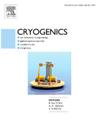Cryogenic helium flow in adiabatic capillary tubes: Numerical insights into choked flow and superfluid behavior in Joule-Thomson cryocoolers
IF 1.8
3区 工程技术
Q3 PHYSICS, APPLIED
引用次数: 0
Abstract
The Joule-Thomson (J-T) effect, utilizing helium as the working fluid, is widely employed for refrigeration in the 1–4 K temperature range. The capillary tube, acting as a throttling element, plays a crucial role in providing flow resistance and regulating flow rates. However, critical information regarding helium flow in the capillary tube—such as the onset of choked flow, the existence of superfluid transition, and the dependence of flow rates and the cooling power on the geometric factors of the capillary tube and operating conditions—remains inadequately understood. This paper presents a numerical analysis investigating the flow dynamics and refrigeration characteristics of helium through adiabatic straight capillary tubes. The findings establish criteria for identifying the onset of choked flow and superfluid transition. Results indicate that helium flow within the capillary tube typically operates in the choked flow regime in practical applications. Should a superfluid transition occur, it takes place in the free expansion region outside the capillary tube, exerting minimal influence on the internal flow dynamics. Furthermore, sensitivity analysis identifies the inner diameter as a crucial parameter dictating the mass flow rate. Design guidelines are also provided for the optimal selection of capillary tubes in cryogenic applications.
绝热毛细管中的低温氦流:焦耳-汤姆逊制冷机中呛流和超流体行为的数值见解
焦耳-汤姆逊(J-T)效应,利用氦作为工作流体,被广泛应用于1-4 K温度范围内的制冷。毛细管作为节流元件,在提供流动阻力和调节流量方面起着至关重要的作用。然而,关于毛细管中氦气流动的关键信息,如阻塞流的开始、超流体过渡的存在、流量和冷却功率对毛细管几何因素和操作条件的依赖,仍然没有得到充分的了解。本文对氦在绝热直毛细管中的流动动力学和制冷特性进行了数值分析。这些发现建立了识别阻塞流和超流体过渡开始的标准。结果表明,在实际应用中,毛细管内的氦气流动典型地以阻塞流形式运行。如果发生超流过渡,则发生在毛细管外的自由膨胀区,对内部流动动力学的影响最小。此外,灵敏度分析表明,内径是决定质量流量的关键参数。设计指南也提供了在低温应用中毛细管的最佳选择。
本文章由计算机程序翻译,如有差异,请以英文原文为准。
求助全文
约1分钟内获得全文
求助全文
来源期刊

Cryogenics
物理-热力学
CiteScore
3.80
自引率
9.50%
发文量
0
审稿时长
2.1 months
期刊介绍:
Cryogenics is the world''s leading journal focusing on all aspects of cryoengineering and cryogenics. Papers published in Cryogenics cover a wide variety of subjects in low temperature engineering and research. Among the areas covered are:
- Applications of superconductivity: magnets, electronics, devices
- Superconductors and their properties
- Properties of materials: metals, alloys, composites, polymers, insulations
- New applications of cryogenic technology to processes, devices, machinery
- Refrigeration and liquefaction technology
- Thermodynamics
- Fluid properties and fluid mechanics
- Heat transfer
- Thermometry and measurement science
- Cryogenics in medicine
- Cryoelectronics
 求助内容:
求助内容: 应助结果提醒方式:
应助结果提醒方式:


